نتحاور
نتحاوَر حول:
المَشاعر: نتحدّث عن مَشاعر الفيل في مشكلته، وفي المَواقف المختلفة، ونلاحظها بعد مساعدة القرد له. نتحدّث عن مشاعر الحيوانات التي أربكَها سلوك الفيل. نتحدّث عن مشاعرنا المتوتّرة أو الغاضبة وسبُل التعامل معها دون تخريب.
ردود الأفعال: نلاحظ سلوك الفيل، وردود أفعال الشخصيّات. ننتبه لاستجابة الفيل لمساعدة القرد، وكيف ساهمت في حلّ المشكلة. نربطها بمواقف من حياتنا وخبراتنا الشخصيّة. كيف نعبّر عن مشاعرنا المؤلمة في الأزمات؟ كيف نساعد شخصًا في أزمةٍ أو ضائقة؟
الأزمات: ضائقة/ مشكلة/ أزمة- ماذا نعني بها؟ هل مررنا بمواقف مشابهة؟ نصفها ونستذكر مشاعرنا فيها. مَن ساعدَنا وكيف؟ هل ساعدنا شخصًا في أزمة أو مشكلة؟
خطوات مساندة: “أهدأ/ قف أرجوك أنا هنا لأساعدك”. هكذا منَح القرد الفيلَ أمانًا ليساعده في الحلّ. نتحدّث عن الخطوات التي تساعدنا في مواقف مربكة. قد نتنفّس ببطء/ نطلب المساعدة/ نجلس في ركنٍ هادئ/ نعبّر عن شعورنا ونسمّيه. ماذا أيضًا؟
البيئة: شكّل الكيس خطرًا على الفيل. نتحدّث عن مساهمتنا في المحافظة على البيئة والأحياء.
نُثري لغتنا
المفردات: نقرأ النصّ ونوضح معاني المفردات. نتعرّف على تسمية المشاعر المختلفة وكيفيّة التعبير عنها.
الأفعال:
نميّز الأفعال الحركيّة: ركض/ اندفع/ هزّ/ طارت/ تقدّم/ داس/ قفز.. نؤدّيها حركيًّا ونلاحظ أثرها. نقترح أفعالًا حركيّةً أخرى ونلاحظ الفرق بينها.
نميّز الأفعال الكلاميّة: صرخ/ تجادل/ تناقش/ تساءل.. نلاحظ الفرق بينها ونقترح ما يلائمنا للتعبير.
نميّز الأفعال الشعوريّة: شعر بالاختناق/ خاف/ ضايق/ غضب. نتحدّث عن المشاعر وإشاراتها في الجسد وتعابيرها في ملامحنا، وطرق التعبير عنها.
الصّفات: نلاحظ صفات فيلون في النصّ، مَن يشبه ممّن نعرف؟ نقارن بين لطفه مع أصدقائه وسلوكه مع المشكلة. نلاحظ صفات القرد وبقية الحيوانات. ماذا نستنتج عن كلّ منها؟
أسماء التحبّب: فيلون صيغة تصغير للفيل. ما هي الصّيَغ التي يحبّها أطفالنا لمناداتهم؟ نلاحظ الصيغ الصرفية الممكنة. قد نضيف للاسم مقطعًا أو نغيّر وزنه.
نلعب
ماذا في الصّورة: نجمع مجموعة صوَرٍ لمواقف حياتيّة، نتمعّن ونتعرّف على المشكلة فيها، ونقترح حلولًا ملائمة. (مثلًا: طفلٌ يبكي/ طفلان يتشاجران على لعبة/ طفلٌ سقط عن الزلاجة).
مَن أنا؟: تتّفق المربّية مع أحد الأطفال على أداء شخصيّة حيوانٍ ما. يقلّد الطفل الحيوان، ويكون على بقيّة الأطفال أن يعرفوه. نوجّه الأطفال إلى التعبير عن الحيوان بالجسد، ثمّ بالحركة، ثمّ بالصّوت.
نستكشف
نستكشف:
الغابة والحيوانات: في النصّ كثيرٌ من محتويات الغابة، ومختلف مواقعها وسكّانها. نبحث عن صوَرٍ ومعلوماتٍ عنها في الموسوعات والمَواقع. نستمتع بالتعرّف عليها وعلى بيئاتها وظروف معيشتها. قد نعدّ موسوعةً خاصّةً نضيفها إلى مكتبتنا، وقد نستعين بها لإنتاج غابتنا في ركن البناء.
نبدع
في بستاننا مسرح: نؤدّي مَشاهد من القصّة. كيف تتحرّك الشخصيّة؟ نلاحظ نبرة صوتها وطريقة تعبيرها. كيف يتحرّك الفيل والكيس في خرطومه؟ كيف تتساءل الزرافة عن حلّ؟ إلخ.
بستاننا أخضر: تسبّب الكيس بمشكلةٍ لفيلون. ماذا يقترح أطفالنا لاستحداث موادّ ومهملات بدلًا من رَميها؟ هل نقيم ورشةً للاستحداث ونُعيد إنتاج الموادّ بطرقٍ إبداعيّة؟ قد ننتج أيضًا مجسّماتٍ للحيوانات من الموادّ المستحدثة.
صندوق الأدوات للأزمات: نخصّص ركنًا صغيرًا في البستان، ونعدّ فيه صندوقًا لمساعدتنا في المواقف المزعجة. نفكّر معًا في أمورٍ من شأنها مساعدتنا في الأزمات، قد تكون جملةً نكرّرها عند الضيق :”أنا منزعج / غاضب/ مرتبك، لكن سأحاول أن أهدأ”. أو مقولةً داعمةً منّا نساند بها بعضنا، مثل: “أنا أحبّك/ أنا معك/ لا تقلق سأساعدك/ تعال نفكّر معًا”. نصغي إلى اقتراحات الأطفال ونضيفها في صندوق أدواتنا، ليلجأ إليها الأطفال عند الحاجة. (مثل: قراءة قصّة/ سماع موسيقى هادئة/ تأمّل صورة لمنظر طبيعيّ).
نتواصل
نتواصل:
نحافظ على البيئة: نفكّر معًا في طرق حماية البيئة والمحافظة عليها. قد نقترح مبادرةً لتنظيف مدخل البستان، أو تزيين البيئة بالنباتات. قد ندعو الأهل والأجداد لمشاركتنا في ورشةٍ خاصّة.
نساند بعضنا: نستضيف أخصّائيًّا في لقاءٍ مع الأهل، ونكتسب طرقًا وآليّاتٍ جديدةً للتعبير عن مشاعرنا، ولمدّ يد العون لمَن هم في ضائقة. قد نبادر أيضًا لمشروعٍ خيريٍّ لدعم المحتاجين في بلدتنا.
نتحاور
نتحاوَر حول…
المَشاعر: نتحدّث عن مَشاعر الفيل في المَواقف المختلفة. نستكشف مشاعر الحيوانات التي أربكَها سلوك الفيل، ونتحادث عن مشاعرنا المتوتّرة أو الغاضبة وسبُل التعامل معها دون تخريب.
ردود الأفعال: نلاحظ سلوك الفيل، وردود أفعال الشخصيّات. ننتبه لاستجابة الفيل لمساعدة القرد، وكيف ساهمت في حلّ المشكلة، ونربطها بمواقف من حياتنا العائليّة.
ضائقة/ مشكلة/ أزمة- ماذا نعني به، وهل مررنا بها؟ نصفها ونستذكر مشاعرنا فيها: مَن ساعدَنا وكيف؟ هل ساعدْنا شخصًا في مشكلة؟
خطوات مساندة: “اهدأ أرجوك، أنا هنا لأساعدك”، طمأن القرد الفيل. نتحدّث عن الخطوات التي تساعدنا في مواقف ضاغطة.
البيئة: شكّل الكيس خطرًا على الفيل. نتحدّث عن مساهمتنا في المحافظة على البيئة والأحياء.
نثري لغتنا
نُثري لغتنا
نقرأ النصّ ونوضح معاني المفردات. نتعرّف على تسمية المشاعر المختلفة وكيفيّة التعبير عنها. نتعرّف على الأفعال في النصّ، معانيها، أصواتها وحروفها. نلاحظها مع المذكّر والمؤنّث.
نتعرّف على الصّفات: نلاحظ صفات فيلون في النصّ، مَن يشبه ممّن نعرف؟ ما هي صفات كلّ فردٍ في عائلتنا؟
نبدع
نبدع
الصّندوق السحريّ: نفكّر معًا في أمورٍ من شأنها مساعدة الطفل في الأزمات، قد تكون مقولةً منّا مثل :”أنا معك وتعال نفكّر معًا”، أو غرضًا يحبّه، أو صورةً لعناقٍ يجمع عائلتنا. قد نضيف جملًا مطمئنة، مثل: “أنا أحبّك” أو جملًا يكرّرها الطفل لنفسه: “أنا منزعج /غاضب، لكن سأحاول أن أهدأ”، أو صورةً لمكانٍ طبيعيّ/ لشخصٍ يتنفّس بهدوء.
نجمع الأدوات في صندوقٍ، نزيّنه ونجهّزه للمَواقف المربكة. قد نتّفق أيضًا على ركن صغيرٍ في بيتنا يلجأ إليه الطفل عند الحاجة، نضع فيه الصّندوق، ليكون مخصَّصًا لتخفيف التوتّر وإعلان طلب المساعدة.
Let's Talk
- About Characters in the story: We can compare the traits of the merchant, the tiger, the bull, and the rabbit. We can deduce what distinguishes them through their behaviour.
- About the Concept of justice and fairness: Does doing good always bring good in return? We might initially think that the good deed the merchant did for the tiger would lead to a disaster, but the cleverness of the rabbit shows us a different outcome. What can we conclude?
- About the Trust: A simple word that can be expressed through feelings, thoughts, and actions. We can recall people we trust deeply. How did that trust develop?
- About experiences from our lives: Have we done a good deed and offered help to someone? We can recall experiences from our lives where we received help or provided it.
Let’s Enrich our Language
- New words and vocabulary: We can familiarize ourselves with unfamiliar words and understand their meanings.
- Punctuation marks: We can observe question/exclamation/quotation marks. What do they mean?
- Proverbs and sayings: We can search for proverbs, sayings, and admonitions that talk about doing good, justice, caution, and other meanings that captivate us.
Let's Create
- Role-playing: Each of us plays the role of one of the story’s characters. We can think about their situation, feelings, and expressions.
- Courtroom game: We can choose situations from our daily lives, and each of us can play a role in defending a different position. Who among us is the judge/accused/lawyer? Who supports another character?
Let's Explore
- Nature: We can go on a hike to the nearby nature. Which trees do we notice? What animals might we encounter? We capture natural scenes and compile them as a memory of our enjoyable outing together.
- Animals around us: Are there any pets in our neighborhood looking for shelter or food? How can we help them safely? (We might prepare a box for cat food or a bird feeder).
Let’s Talk
- About Our child’s desires and dreams: We can talk about them, reflect on whether they are achievable, and explore how to turn desires into goals and what helps us achieve them.
- About Problem-solving: What challenges have we faced, and how have we successfully invented solutions? We can recall our child’s successful experiences.
- About Natural phenomena: We can observe a natural phenomenon, listen to our child’s explanation, and explore its scientific reality together, such as falling leaves, sunset, and sunrise, cloud formation, and rain.
- About Gifts: What gifts does our child wish to receive? What surprise gifts have delighted them?
- About Our shared experiences: What activities does our child want to participate in together? We can brainstorm ideas for an enjoyable and meaningful time together.
Let’s Enrich our Language
- The moon: We can learn the basic phases of the moon (crescent, full, new). We familiarize ourselves with the concept of lunar months.
- Nisan: It is one of the months in the Gregorian calendar (solar). We can recall the months and observe the characteristics of each of them.
- Meanings of Words: We can clarify new words and explain their meanings (gap, dim, stillness). We can think with our child about words that sound or mean something similar.
Let’s Explore
- Light and shadow: We can choose a room for a nighttime game, turn off the lights, and use lamps to explore the images we can create by reflecting our shadows on the wall. We can invent shapes and movements and enjoy their shadows.
- Moon phases: We can observe the moon for several days. We may photograph or draw it and compare its different phases. We may seek information from scientific sources.
Let’s Create
- Enjoy songs and poems about the moon. We can perform expressive movements, dancing together to their tunes.
- Prepare a moon-themed board: We can add shiny crescent-shaped strips to a black cardboard every day until it completes the full moon shape.
Let's Talk
- About Birthdays: What makes our birthday a special day? What celebrations do we desire? What activities and events do we want? What gifts have we received or wish to receive?
- About Love and Care: How do we feel when everyone collaborates to make us happy? How do we feel when we care for others and prepare surprises for them? We can recall enjoyable moments when our loved ones surprised us and we can discuss different ways to express love. We may agree on a daily or weekly activity to add a special touch to our lives, such as preparing a meal together, reading stories, playing together, and visiting grandparents. What else can we do?
- About Collaboration: The family members collaborate and share tasks, making their child’s day joyful. We can think about the roles each of us can take to help and make others happy.
Let’s Enrich our language
- We read the story and explain the meanings of new vocabulary. We can pause at scenes and describe the drawings.
- Creating a card for our family: We can add our names and a picture that brings us together, or some words of thanks and love. We can color and decorate it, then hang it in a special place in our home.
Let’s Sing
We can learn poems and songs about birthdays, love, and family. We can repeat them and perform suitable movements alongside it.
Let’s Create:
We can prepare a surprise for one of the family members. What can we choose? We can think about what they like or need, tailoring the surprise to them. We may agree to make every weekend a special day for one family member.
Let’s Play
What if we exchanged roles for a day in our home? Who would be the father/mother/child? We can have fun thinking about others, describing their feelings, and expressing them.
Let's Talk
- About the child’s feelings: We can read the story with our children several times. We then follow the illustrations and discuss them as an expressive panel and talk about the feelings of both the child and the grandfather during their joint activities.
- About the relationship with the grandfather: We can talk to our child about the things he loves about his grandfather and grandmother, and the things that sometimes bother him.
- About Family relationships: The book presents the child’s experience of spending enjoyable time with her grandfather. We can talk to our children about the shared activities that our children love to do with their grandparents, aunts, uncles, and extended family.
Let's Create
- Let’s prepare an album of the most beautiful moments with family members and relatives.
- Let’s plan and create a house for our favourite pet with the help of grandparents.
Let's Communicate
Let’s visit our grandparents and initiate a fun activity together, such as gardening, going for a nature walk, playing chess, and more.
Let’s Talk
- About the title: We can ask the children what is meant by “nothing” in the gift box?
- About the meaning and value of the gift: We can talk about the meaning of the gift, asking our children: Why do you think the cat wanted to give the dog a gift? Is it important for us to give each other gifts? How do we feel when we receive a gift?
- About ways of expressing love: The gift is often a way of expressing love. We can ask our children: How can we express our feelings, such as love, appreciation, and concern for friends and family in ways other than giving material gifts?
- About Drawings: The drawings in this book have a “comic” style. We can explore with our children where this style is used to convey information or tell a story (such as advertisements, children’s magazines, etc.).
Let's Create
We can think about a special person in the child’s life whose birthday is coming up, and we can prepare a special gift for them, such as a photo album of beautiful moments spent together, a photo frame, a card expressing our love, creatively wrapped.
Let’s Enrich our Language
“Nothing” is a commonly used term in our colloquial language, as in the story, and is often used metaphorically. We can follow different situations in the story, replacing the term “nothing” with a detailed sentence expressing the situation, and encourage our children to express themselves.
نتحاور
نتحاوَر حول:
الهدايا: لماذا نتبادل الهدايا؟ وما المعاني والقيَم التي تعبّر عنها؟ أيّة هدايا نحبّ أن نتلقّى؟ أن نقدّم؟ لمَن؟ ما الفرق بين الهدايا المادّيّة والمعنويّة؟ قد تكون الهديّة كلمةً طيّبةً/ تشجيعيّة/ نظرةً دافئةً/ مساعدةً نقدّمها، ماذا أيضًا؟
ذكرى الميلاد: كيف نشعر في ذكرى ميلادنا؟ ما المفاجآت التي تجعل من هذا اليوم مميَّزًا. نستمع إلى خبرات الأطفال.
الصّداقة: مَن هم أصدقاؤنا؟ ماذا نحبّ أن نفعل معهم؟ نشارك بخبراتنا الذاتيّة. نستذكر هدايا معنويّة تبادلنا مع أصدقائنا (هل لعبنا معًا؟/ ساعدَ أحدنا الآخر/ كيف نشعر بمشاركة الأصدقاء ووجودهم؟).
شخصيّات القصّة: من هما وديع ونبيل؟ نتحاور حول احتياجات الكلب والقطّ والإنسان، بماذا تختلف؟
Let’s Talk
- About the Title: What distinguishes a hotel from a house? Are there other words with the same meaning? How should we behave in a hotel?
- About Differences: People and animals have different needs, and the girl and her mother tried to accommodate the rooms accordingly. Let’s follow the drawings, discuss the needs of each visitor, and explore how the girl responded to them.
- About Personal Traits: we can ask our child about the girl’s qualities and how they manifested in her actions. We can also discuss our child’s unique qualities compared to siblings or peers and how they are presented in their behavior.
- About fostering responsibility and a sense of belonging: we can talk to our child about the roles they enjoy taking on at home and the roles each family member plays. We can emphasize how these roles express real responsibility and a sense of belonging.
- About Solving Problems Creatively: we can recall situations at home that required unconventional solutions, and how we successfully overcame them together. We can explore further by researching information about the animals mentioned in the story and their characteristics and habitats.
Let’s Explore
We can search the encyclopedia or the internet for information about the animals mentioned in the story, about their characteristics and how they live.
Let’s Create
The book’s illustrations beautifully capture the harmony between the setting and the different character traits. We can delve into the charming details of the drawings, create or design rooms for other animals based on their features.
Let’s Communicate
We can take a stroll around town and look for signs indicating accessibility for people with special challenges. We can take their picture with our phones and discuss their importance for inclusivity in general.
Let’s Talk
- About problem-solving: We can ask our children about the problems the animals faced, how they behaved, how the problem escalated, and how they found a solution.
- About feelings and thoughts: We can trace the drawings, describing the characters’ emotions and actions in different situations. We can give “qualities” to each character.
- About Cooperation and confidence: With our children, we can recall some family and school challenges that everyone successfully overcame as a group, emphasizing the importance of each person’s role. We discuss with our children their roles in overcoming these challenges.
Let’s Explore and Initiate
We contemplate; we can search for and present problems in our neighbourhoods and towns, such as garbage issues, and brainstorm ways to address them.
Let’s Act
We can act out situations where our child may face individual or group problems and discuss ways to cope with them, such as a disagreement with a friend, losing a game, a student getting injured on a school trip, or facing bullying from an individual or a group.
Let’s Create
With our child, we can prepare an “I Can Jar:” Together, we can write phrases on paper scraps describing things we can do together that benefit us and others. We can identify a positive change we want to make, for example: “I can say no to bullying,” “I can help a friend in need,”
Let’s Talk
- About Feelings: we can read the story with our children and talk about “Tala” and “Fadi’s” feelings from the beginning to the end. We can ask our children: How did they feel and how did these feelings change?
- About New Beginnings: we can share our feelings about new beginnings with our children, such as the first day of school or joining a new club. We can ask our children about their feelings in new beginnings: what makes them feel secure, and what helps them overcome feelings of fear or dread. We can remind them of situations where they adapted successfully.
- About Friendship: “Tala” was able to form a friendship with “” We can follow the text and illustrations with our children and ask them how that friendship formed, what they did together, and how friendships are made. We can also ask our children who their friends are and what they like to do with them.
Let’s Play and Work Together
We can initiate a fun and shared activity, such as recalling things we love to do together, like going on a family picnic, reading a book, or preparing a favorite dessert and more. We can try to allocate time during the week to enjoy an activity or more with our child.
Let’s Explore
We can explore and learn about pets and how we can take care of them at home, and about the relationships that form between the animal and its owner.
Let’s Communicate
We can invite one of our child’s friends to visit our home or participate in a shared activity, like a park trip, to strengthen social relationships and support them in building friendships.
This book offers you a chance to go on a journey with your child that will make your home town be the beginning and the end.
- The text starts with a poem about our home town. We can talk with our child about our town’s characteristics, and switch the last sentence with a one that relates to our town.
- Who are our neighbors? We can talk with our child about the nearby villages and towns that he visits sometimes and see what connections he makes to each one.
- The illustrations highlight the most prominent spots in each town and village. We can help our child to identify these spots through the illustrations such as the Dome of Bahai or the light house of Akko.
- Does the book motivate us to go on a journey to different places? It would be nice to go and take family pictures and then hang them on the string in the last two pages of this book. We can also collect all the pictures in a small memory box.
- It would joyful to make colorful kites for the family.
Let’s talk about:..
Let’s talk about:
– Use of screens: We may ask our children: Why do you think the parents prevented Rani from watching the screen so much? How does the continuous looking at screens affect us? How do we feel when our family sits with us while they are busy with their screens? – Alternatives to Screens: Rani’s father suggested alternative activities to his son. We can talk with our child about things they like to do on their own and things they like to do with us, and we can include them in our weekly schedule. – Boredom: We can talk to our child about the times when they were bored. What helps them to overcome this feeling? We can share our feeling of boredom and how we deal with it with our child.
Let’s communicate:..
Let’s communicate:
– We can reduce the time we spend on screens and play with our children. We might read an interesting book together, go for a walk, listen to music, or prepare a delicious meal. It would be great if we set aside a consistent weekly time for these activities.
Let’s create...
Let’s create:
create: – We can help our child prepare a weekly calendar, in which they draw icons that symbolize activities they like to do alone or with their friends and family members. They will definitely be proud when they see it hanging on the fridge in the kitchen! – We can devise an agreement with our children about how long they sit in front of the screens and how to use screens at home, and we will stick to this agreement as a family.
Let’s explore...
Let’s explore:
– We can explore apps in our mobile for fun family games. – We can search for the benefits and drawbacks of using screens for continuous periods with our children.
Dear Parents
,Dear Parents
Did it happen to you that you really wanted something? what did you do? How did you deal with that desire? Who supported you?
Our rich book presents several topics and deals with them in a clever way through the plot. It first raises the issue of dealing with not getting our desires and wishes and how to cope with it, and how to deal with the frustration of our children.
It is important to give legitimacy to this feeling and to offer them the space to express it and not disregard it; Through this, the child will be able to deal with this feeling more effectively by looking for ways to overcome it. It is also important to support our children in developing the skill of patience and how to contain feelings of frustration, and to talk to them about our inability to get everything we want immediately. One of the ways that they can deal with and tolerate frustration is to use imagination, which is a partial fulfillment of our needs through envisioning, so that when the child’s desires are not fulfilled in life and in reality, they can simply imagine.
The book also presents a method for dealing with our desires and achieving them. Flexibility of thinking and developing the ability to search for other additional solutions, even if they seem difficult or almost impossible, is a great way to deal with these topics. It is important to also train our children to be flexible thinkers and to suggest alternatives, especially in real life situations.
:Let’s talk
About desires and wishes: Mountain wanted to see the sun, but he couldn’t. We can talk to our child about the things they want and desire: which things can they have, and which are hard for them to get? How do they feel? We can think together and suggest different ways to fulfill our desires.
Feelings: We can follow the drawings with our children and talk about the various feelings of Mountain and his friends. We can name them and ask the children about their causes, such as: feelings of frustration when he could not see the sun; feeling excited; Sympathy from friends. We can connect feelings to their effect on our behavior.
Solving problems: Mountain’s friends tried to deal with his problem by suggesting several solutions. We can talk with our children about the solutions that his friends have suggested and offer others that they have not. We can train our children to be flexible, creative outside-the-box thinkers.
Helping and Cooperating: Mountain’s friends sympathized with him and tried to fulfill his desire to see the sun. We can ask our children: Did anyone help them get something they wanted? Then we can also ask: Who supported them? How did they feel?
Let’s play and imagine:
We can choose an object, think outside the box, and suggest many uses for it beyond the well-known traditional use.
Let’s act and innovate
We can train our children to think flexibly by suggesting issues and problems that our child faces in daily life and searching for and acting out many solutions.
Let’s explore
We can go out to nature with the family to observe the mountains and witness their beauty and the life of the creatures living there.
!Enjoy your reading
كتاكيت: الفانوس في الحضانات
عن الكتاب:
يعترض دبدوب على طلب أبيه أن ينفصل عن ألعابه ويذهب إلى النوم؛ لكنّ الأب يحوّل الموضوع إلى طقس ظريف يسهّل استعداد صغيره للنوم من خلال تقليد قبلات الحيوانات المختلفة.
على فكرة:
- في عمر السنتين، يريد الطفل اتّخاذ القرارات والتصرّف لوحده، وكثيرًا ما يعترض على طلبات أهله. يعطينا الأب نموذجًا لاعتبار قرار الطفل بعدم تقبيله واحترام حدود جسده، وإعطائه مساحة للتعبير عن ذاته، واحتواء انفعالاته العاطفيّة بشكلٍ مرن وهادئ.
- انفصال الطفل عن ألعابه ونشاطه خلال النهار يثير توتّر أغلب الأطفال. إنّ القيام بطقوس ثابتة تخفّف من قلقهم، وتمنحهم شعورًا بالسيطرة والطمأنينة.
- في القصّة علاقة دافئة بين االدبدوب وأبيه، وفي الواقع يفتقد العديد من الأطفال حضور الأب في البيت. نتيح المساحة للأطفال للتعبير عن مشاعرهم، ونُبرز مكانة المربّية الحاضرة في حياة الطفل، أُمًّا كانت أم جدّة أو غيرهما.
بعد القراءة
في الحضانة:
- نتحادث: في مجموعة صغيرة، نتحادث مع الأطفال حول طقوس النوم الخاصّة بهم.
- نثري لغتنا: نقرأ الكتاب ونركّز على مفردات مثل: كبير وصغير، غضبان، يقبِّل وينشِّف، ونشجِّعه على استعمالها في حديثه.
- نبدع: نُحَضِّر مع الطفل دمية “دبدوب” من جورب صوفٍ، ونتعرّف على ملمس الموادّ.
- لوحة القُبلات: نعلّق في مدخل الحضانة لوحة عليها صور لقُبل الحيوانات. نشجّع الأهل على سؤال الطفل قبل دخوله الحضانة: أيّ قُبلة تختار اليوم؟
مع العائلة:
- نتحادث: حول خطوات الاستعداد للنوم. يمكن تصوير الطفل في كلّ خطوة، وتعليق الصّور ليستدلّ بها الطفل كلّ ليلة.
- نلعب: نتعرّف على الحيوانات المذكورة، ونقلّد حركاتها. اللّعب المرح مع طفلنا يوطّد علاقتنا معه ويعزّز مهاراته العاطفية..
- نثري لغتنا: نستعين بالدّمية لنمثّل نشاط الحمّام والاستعداد للنوّم مستخدِمين الأفعال والتعابير ذات الصلّة كي يذوّتها الطفل ويستخدمها في سياقاتٍ حياتيّة مختلفة.
نشاط مع الأهل
- في كلّ صفحةٍ يقبّل فيها الأب ابنه كما يقبّل حيوانٌ صغيره، يختبئ رمزٌ يدلّ على هذا الحيوان. قد يكون في لوحة معلّقة على الحائط، أو في ثياب الأب. يمكننا أن نتتبّع مع طفلنا هذه الرّموز، ونشجّعه على اكتشافها.
- لا شكّ في أنّ طفلنا سيضحك كثيرًا إذا رافقنا قراءة القصّة بتقبيله كما يفعل الأب في القصّة!
- كيف يقبّل القطّ الصّغير أباه وأمّه؟ وما رأيكم في قبلة النّحلة مثلًا؟ قد يتمتّع الطّفل باقتراح حيواناتٍ مختلفة، واختبار قبلاتها!
- قبلة الفأرة لها شوارب، وقبلة القرد نطّاطة وملتويّة! يعجّ النّص بأوصافٍ حسّيّة مرحة للقبلات، ممّا يُغني خيال الطّفل، ولغته الوصفيّة، وخبرته الحسّيّة. من الممتع أن نفكّر معًا بأوصافٍ لقبلات حيواناتٍ جديدة.
- يرفض دبدوب أن يبدأ الاستعداد للنّوم، كما يفعل العديد من الأطفال الّذي يستصعبون أن ينفصلوا عن ألعابهم، ويحتاجون إلى مرافقتنا في هذا المعبر اليوميّ. يمكن أن نتحادث مع طفلنا حول أهميّة النّوم لعددٍ كافٍ من السّاعات، وفي ظروفٍ مريحة لجسمنا.
- يمكننا أيضًا أن نستذكر مع طفلنا طقوس استعداده للنّوم. ماذا يحبّ؟ وماذا لا يحبّ؟ قد نرغب بأن نشاركه ما يساعدنا نحن على التّهيّؤ للنّوم، مثل احتساء شرابٍ ساخن، أو قراءة كتاب، وغيرها.
- قد نرغب في أن نبني معًا “علبة القبلات في عائلتنا”. يمكن أن نزيّن علبةً كرتونيّة أو خشبيّة بقبلاتٍ يطبعها أفراد العائلة، مستعينين بقلم شفاهٍ صارخ اللّون. هذه علبة جميلة لخزن أغراضٍ عزيزة على قلب طفلكم!
أفكار لدمج الكتاب في الصّفّ
- يمكن أن تتحادثي مع الأطفال حول طقوسهم في الاستعداد للنّوم. ماذا يحبّون، وماذا لا يحبّون؟
- القبلة هي إحدى تعابيرنا عن الحب. يمكن أن تتحادثي مع الأطفال حول التّعبيرات المختلفة عن الحبّ الّتي يعيشونها في الرّوضة وفي البيت، كأن يشاركوا أصدقاءهم بنشاطٍ يعنيهم، أو أن يهدوهم هديّة، وغيرها.
- لمن نهدي قبلتنا؟ ادعي الأطفال إلى تخبئة قبلة في كفّات أيديهم، ثم تطييرها لشخصٍ يحبّونه. شجّعي من يرغب من الأطفال في الحديث عن الشّخص الّذي يتلقّى القبلة.
- العديد من الأطفال لا يحبّون التّقبيل، أو قرص الخدّ، أو الضّمّ الشّديد. هذه مناسبة للحديث مع الأطفال حول مشاعرهم في مواقف كهذه، وكيف يمكن أن يتصرّفوا على نحوٍ لا يعرّضهم للمضايقة.
- قبلة نطّاطة، وقبلة لها شوارب، وقبلة مقلوبة، هي بعض من القبلات الّتي تعطيها صغار الحيوانات لآبائها. أيّة قبلة سنعطي البابا/الماما اليوم حين يخرج/تخرج من الرّوضة صباحًا؟
- شجّعي الأطفال على التّفكير في حيوانات أخرى غير مذكورة في الكتاب، وتخيّل أوصاف لقبلاتها. ما صفة قبلة الأسد مثلًا لصغيره، أو قبلة النّملة؟
- من الجميل أن تجمعي من مكتبة البستان كتبًا أخرى حول علاقة الأب مع أطفاله، مثل كتاب “تعال العب معي” أو “نسيت أجنحتي في البيت” وقراءتها مجدّدًا مع الأطفال.
- تجدين في صفحة الفانوس اللّغوي (أنظري “روابط نوصي بها” في صفحة الكتاب) اقتراحاتٍ لأنشطة لغويّة حول الكتاب.
الفانوس اللّغويّ
المربّية العزيزة،
توفّر الكتب فرصًا لإثراء كافّة المجالات لدى الطفل: المعرفيّ والشعوريّ والحركيّ والإبداعيّ. بالإضافة إلى الأنشطة المقترَحة للأهل مع الكتاب وفي موقع مكتبة الفانوس، وإبداعات المربّيات الفنيّة، نخصّص هذا الرّكنَ لإضاءاتٍ في التربية اللغوية يمكن أن تتيحها القصص المقترَحة ومن شأنها أن تساهم في تنميَة مهاراتٍ لغويّة عبر سياقٍ حيويّ يعني الطفل.
ماذا في الكتاب؟
في نظرة:
- الرّسومات تعبّر عن مشاهد حركيّة، توفّر فرصةً للحوارات الوصفيّة وللحديث عن ظروف المكان والعلاقات المكانيّة والاتّجاهات (الدبدوب أعلى الأب، في حضنه من الأسفل، كفّ الدبدوب على فم والده، ذراعا الأب مفتوحتان إلى اليمين واليسار… إضافةً إلى أشكال القبلات المختلفة للدبدوب)..
- ثمّة علاقةٌ بين كلّ صورة وطبيعة الحيوان الذي يصف النصّ قُبلته: فرصة لنبحث عن العلاقة وصفًا ونقلّدها حركيًّا.
- أحجام الدبدوب الطفل والأب، وألوان صوَرهما مفتاحٌ لتنمية القدرة على المقارنة.
في قراءة:
- النصّ غنيٌّ بمفرداتٍ جذّابة خاصّةً أسماء الحيوانات وأوصاف القبلات.
- النصّ غنيّ بالأفعال الماضية والمضارعة، وبالأفعال الحركيّة والصّوتية.
- المفردات سهلة وسلسة. وبعضها يمكن التعبير عنها في حركاتٍ جسديّة.
- ثمّة كلماتٌ مسجوعة، تحديدًا في بدايات النصّ.
نقترح:
- استثمار الفرصة لتطوير حواراتٍ وتنمية الكفايات اللغوية: إغناء القاموس اللغويّ والشعوريّ ومهارات التدواليّة: الوصف والمقارنة بشكلٍ خاصّ.
- التعرّف إلى صيَغ الماضي والمضارع مع الضمائر المختلفة (صيغة الفعل فقط دون داعٍ لتسمية الزمن. يمكن القول مثلًا : أمس ناولتُ والآن أناول، أمس ضحكنا والآن نضحك…).
- تطوير ألعابٍ لتنمية مهارات الوعي الصّوتيّ: تمييز السّجع والاستمتاع به، ومعرفة الحروف.
- تطوير ألعابٍ تجمع بين المفردات والحركات المعبّرة عنها.
قبل الانطلاق:
- ضمن باب الإقبال على الكتاب في المنهج اللغويّ نبتغي أن يتعرّف أطفال الرّوضة على النصّ والرّسوم التوضيحيّة ويفسّروا العلاقة بينهما.
- في مجال الكفايات اللغويّة نسعى أن يُثريَ أطفال الرّوضة قاموسَهم اللغويّ، أن يميّزوا انفعالاتٍ مختلفةً من خلال النصوص المسموعة، وأن يتحدّثوا مع البالغين حول موضوعاتٍ مختلفة. والنصّ يتيح حواراتٍ عاطفيّةً، عن تجارب خاصّة.
- في مجال معرفة الحروف ينبغي أن يميّز أطفال الروضة قسمًا من الحروف ويلائموها لصورتها. لذا نحرص مع كلّ كتابٍ أن نتعرّف إلى بعض الحروف الواردة فيه.
تعالَوا نتحدّث:
- نتحاور حول الصّور والنصّ. نصِف ما تعبّر عنه الصّورة ونقلّده بحركاتٍ ملائمة.
- نتحدّث عن شعور دبدوب، عن الغضب من تعليمات الأهل، متى نحسّه؟ ونتحدّث عن انفعالاتٍ ومشاعر مختلفة. ماذا نحسّ لو حدث موقفٌ ما؟
- ماذا كان يمكن أن يفعل دبدوب أو يقول ليقنع والده بعدم النّوم؟ (مثل هذا السؤال يهدف إلى تنمية مستويات التفكير المتعددة).
- نصِف الشخصيات المذكورة وقبلاتها، نفكّر في حيواناتٍ أخرى وأشكالٍ أخرى ممكنة من القبلات.
- لنتذكّر: نحرصُ على طرح أسئلةٍ مفتوحةٍ كمشكلةٍ نسعى ليشاركنا الأطفال بحلّها، كي نتيح إمكانياتٍ أوسع للتعبير. ونحرص على تقبّل واحترام كلّ الإجابات.
حفل الكلمات:
غضبان، قبلة، قبلات، يعانق، دَبِقة، يُطبق فكَّيه، وطواط، زمجرَ…
- نختار مع الأطفال المفردات/ العبارات/ المقولات التي جذبت الأطفال، ننتقي مفرداتٍ شعوريّةً أو عباراتٍ وصفيّة، ونخصّص ركنًا للاحتفاء بها، ونطوّر حولها أنشطة لإغناء القاموس اللغويّ للطفل، نرسمها، نقلّدها، نتحدّث عن أمورٍ تتعلق بها، قصص وردَت فيها…
- نلعب مع كلمات من نفس الجذر في أوزانٍ مختلفة لتنمية الوعي الصّرفيّ (مثلا: دب- دبدوب).
الوَعي الصوتيّ ومعرفة الحروف:
- نقطّع الكلمات، نتحرّك مع المقاطع وفق وصف القبلات.
- نميّز النغمات ونبحث عن نغماتٍ متشابهة بين الكلمات في النصّ.
- نتوقف عند الكلمات المسجوعة ونخمّنها، وننتج سجعًا إضافيًّا.
- نختار حروف “دبّ ودبدوب”، نلعب مع الدّال والباء، نغنّي للحرف، نكتب كلماتٍ يتواجد فيها، نقفز إلى حلقاتٍ فيها تلك الكلمات.
الوعي الصّرفيّ:
- نلعب على نمط “برّ- بحر” ألعابًا في تصريف الأفعال بين الماضي والمضارع. في قسمٍ منها أمس والقسم الثاني اليوم، ليتحرّك الأطفال إلى الضّفّة الملائمة للفعل المذكور.
- نلعب مع الأوزان، وننتج كلماتٍ من ذات الوزن )دبّ- دبدوب، حبّ- حَبحوب، جبّ- جَبجوب). مثل هذه اللعبة تضفي أجواءً من المرح والمتعة وتنمّي مهارات الوعي الصّرفيّ وإدراك العلاقة الصرفية.
الكفايات اللغويّة:
- نقارن بين الصّورة والنصّ، ونعبّر عن حركات الدّبدوب بالكلمات.
- نتوزّع في فريقَين: فريق يقوم بحركاتٍ بجسده، وفريق يصِف الحركات بالكلمات ثم نتبادل الأدوار. (لتطوير التداوليّة والوصف).
- نتخيّل حيواناتٍ أخرى ونتخيل قبلاتها، نصفها ونقلّدها.
ماذا أيضًا:
- نحضّر صوَرًا تعبّر عن حركات، نكتب مع الأطفال الكلمات التي تعبّر عنها ونضيفها إلى مركز الرّياضة.
- نرسم قبلاتٍ لحيواناتٍ نختارها ونكتب اسم الحيوان.
- نصوّر حيواناتٍ أو نطبع صورها من الإنترنت، ونضيف أسماءها لنُعدّ موسوعةَ الحيوانات المحبوبة.
- نعدّ كتابَ القبلات من رسومات وأوصاف الأطفال، ونتركه بين متناول أيدي الأطفال.
لنتذكّر: هذه الإضاءة مختصّةٌ بالمجال اللغويّ وحسبُ، لذا نقترح على المربّيات متابعة المقترحات الموسعة عبر موقع مكتبة الفانوس.
عملًا ممتعًا..
إعداد: أنوار الأنوار- مرشدة قطريّة ومركّزة التربية اللغويّة في رياض الأطفال العربيّة
Look through the...
Look through the book together and examine the unusual illustrations that accompany the text. Notice the various perspectives the illustrator used in creating these pictures. Which pictures show the action from above—and which from the side? Talk with your children and ask them why they think the illustrator chose to portray the events on the bridge as she did.
Sometimes, before we...
Sometimes, before we arrive at a good idea, we first have to try (and discard) some not-so-good ideas. Together with your children, go back over the various solutions which the bear and the giant proposed in the story. What are the upsides and downsides of each idea?
Do you remember...
Do you remember the game of “Golden bridge”? Stand opposite your child and hold both his hand high to form a bridge. Invite other family members and friends to pass under the bridge, while singing: “Oh Golden bridge, Oh golden bridge/ we all pass under you and someone will be caught”. Whoever is passing the minute you say “caught” is out.
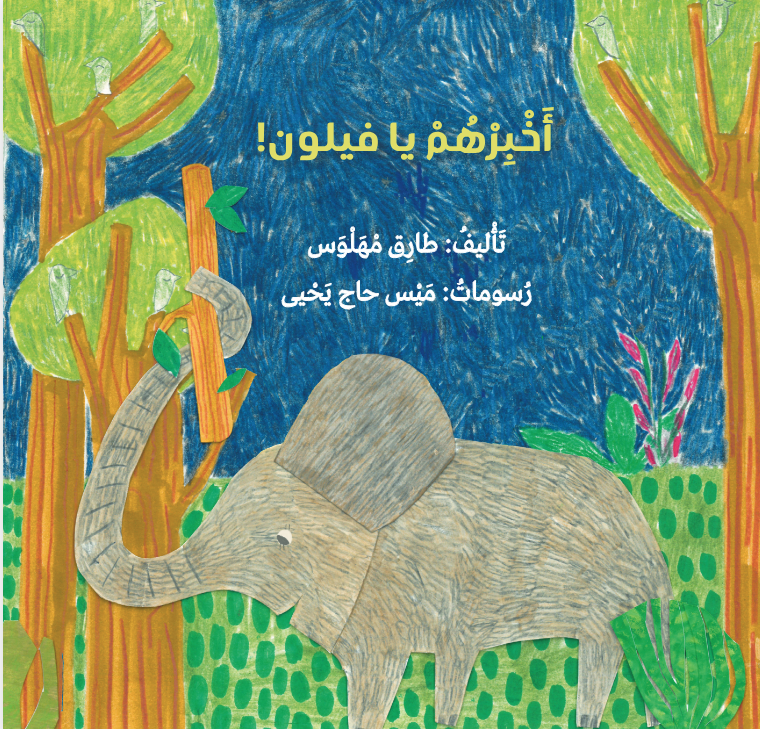 Fayloon
Fayloon  Don’t Trust the Tiger
Don’t Trust the Tiger 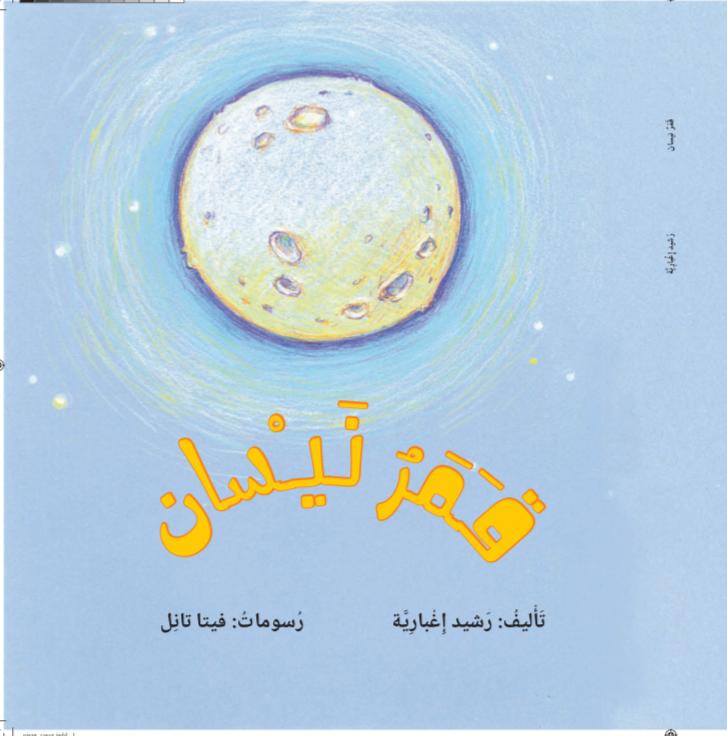 Nisan’s Moon
Nisan’s Moon 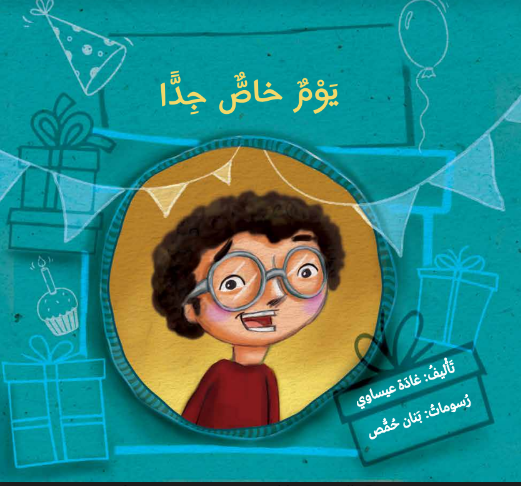 A Very Special Day
A Very Special Day 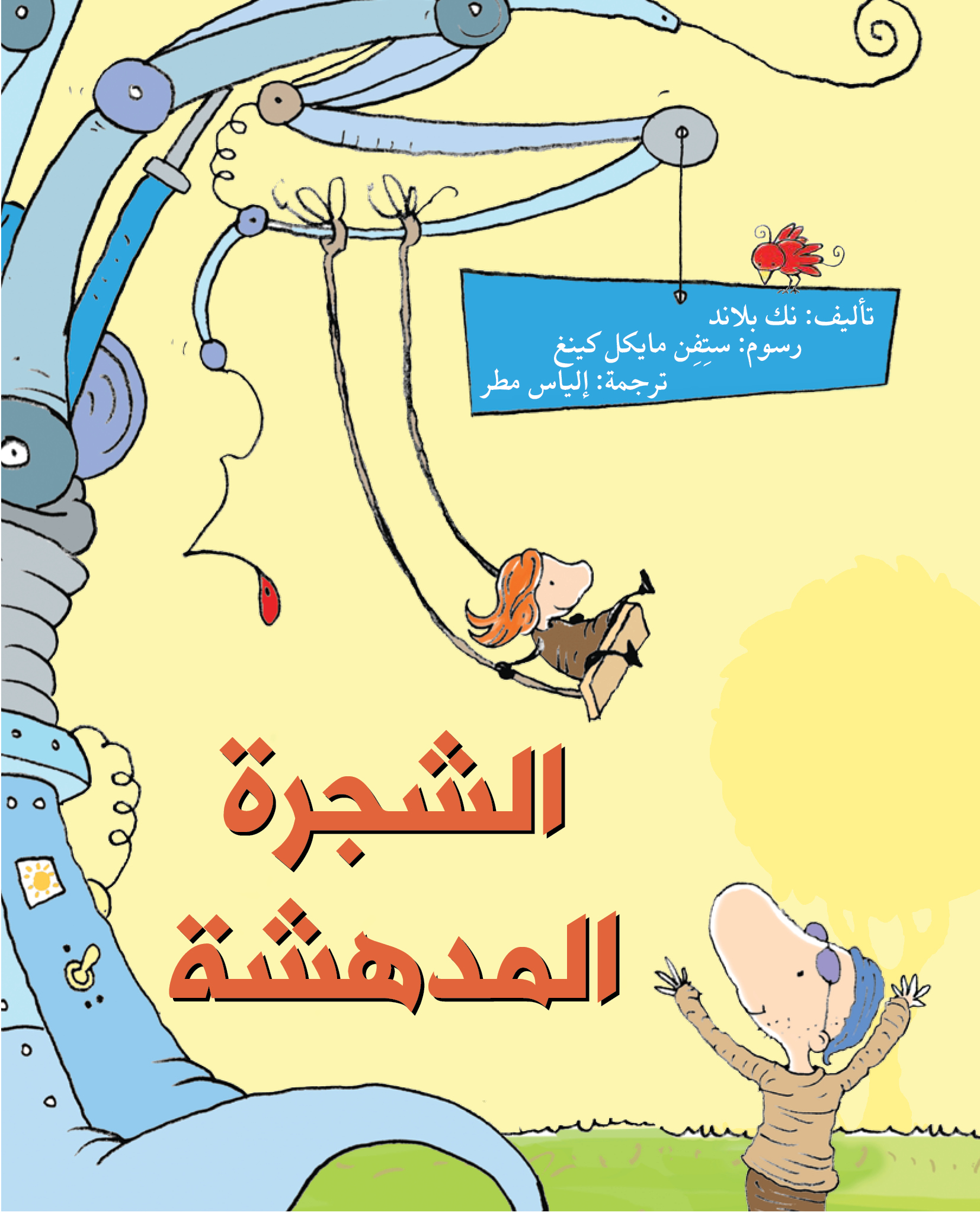 The Amazing Tree
The Amazing Tree 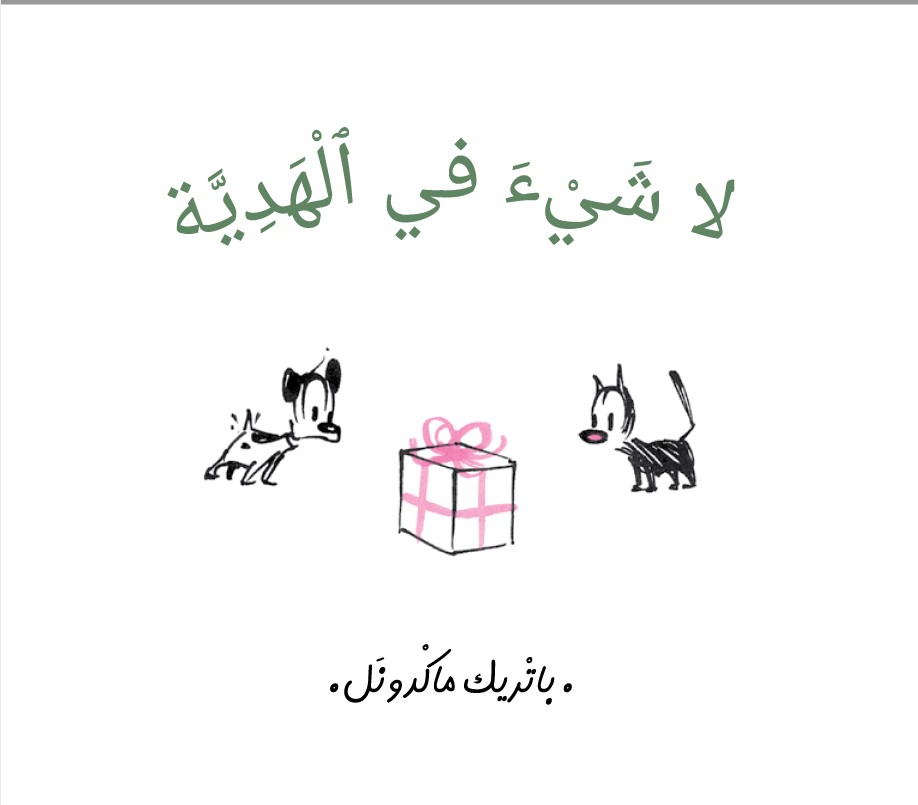 The Gift of Nothing
The Gift of Nothing 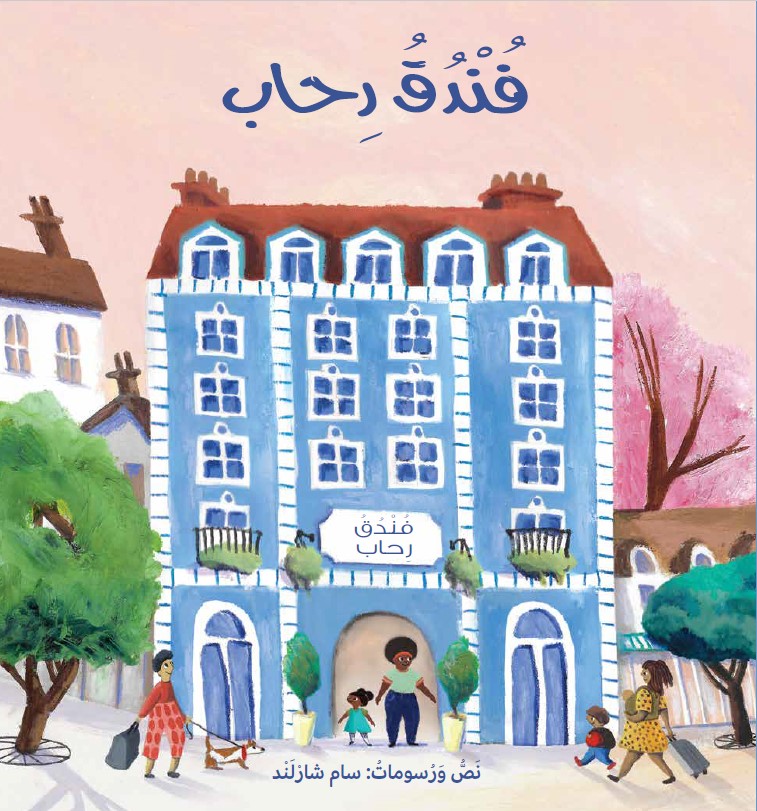 Rihab’s Hotel
Rihab’s Hotel  When Water Flooded the City
When Water Flooded the City 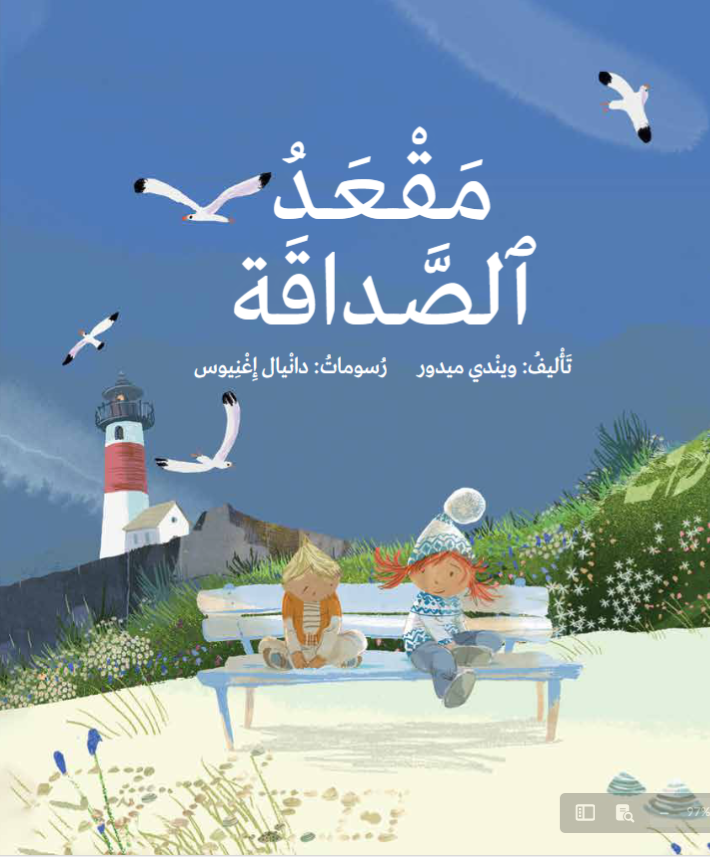 Friendship Bench
Friendship Bench 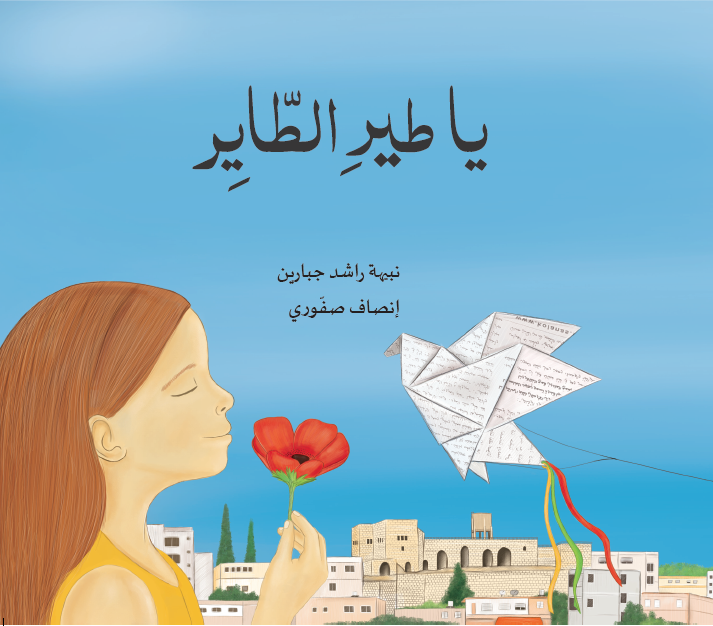 Oh Flying Bird
Oh Flying Bird 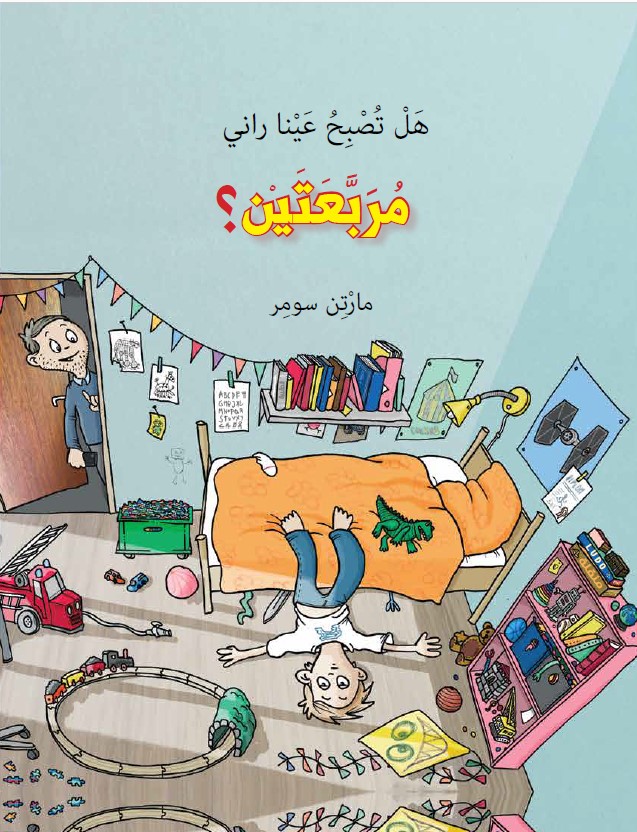 Will Rani’s eyes become square?
Will Rani’s eyes become square? 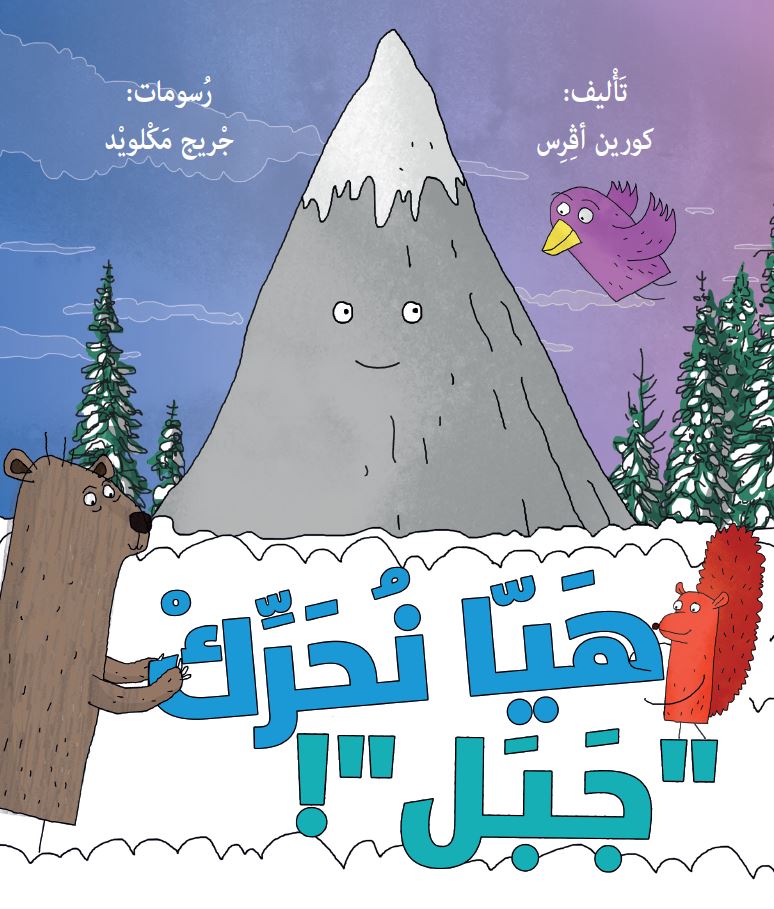 Move mountain
Move mountain 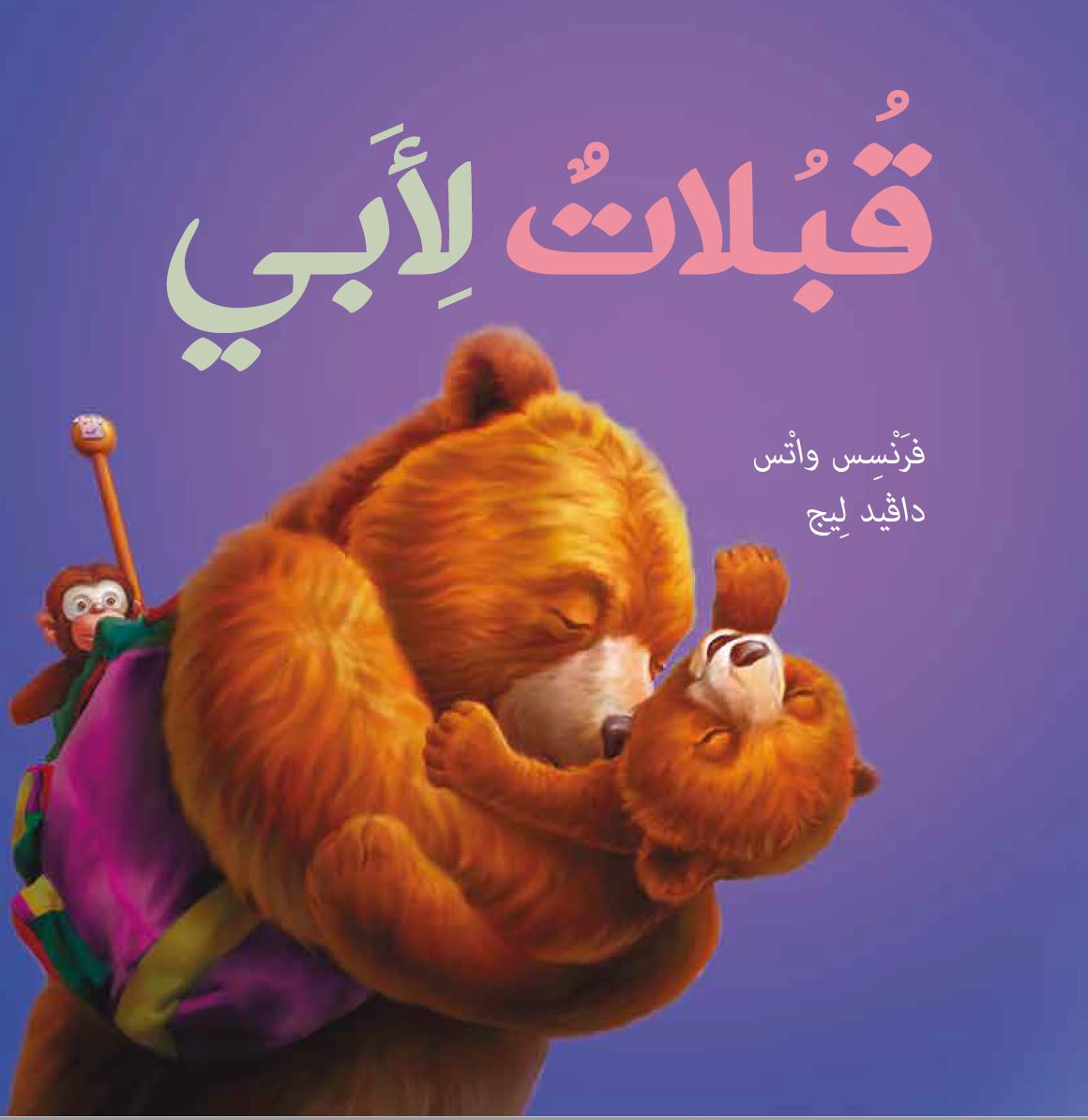 قبلات لأبي
قبلات لأبي 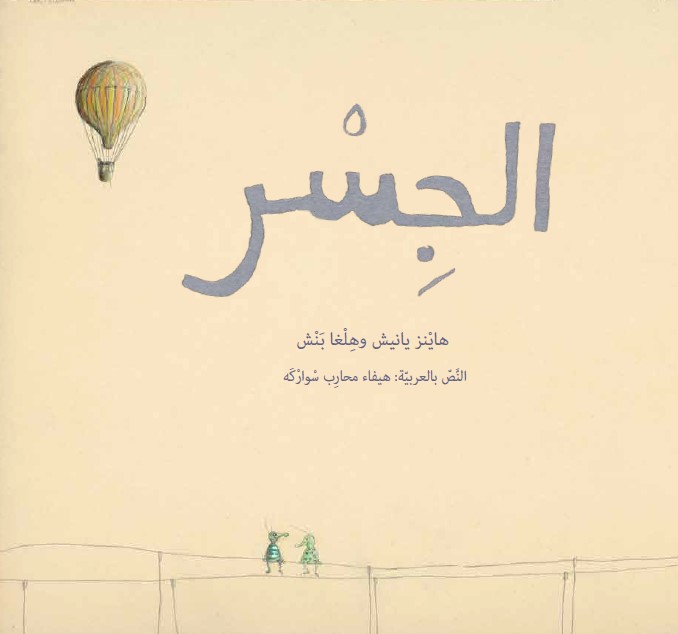 The Bridge
The Bridge 
